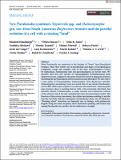Por favor, use este identificador para citar o enlazar a este item:
http://hdl.handle.net/10261/348632COMPARTIR / EXPORTAR:
 SHARE SHARE
 CORE
BASE CORE
BASE
|
|
| Visualizar otros formatos: MARC | Dublin Core | RDF | ORE | MODS | METS | DIDL | DATACITE | |

| Título: | New Parabasalia symbionts Snyderella spp. and Daimonympha gen. nov. from South American Rugitermes termites and the parallel evolution of a cell with a rotating “head” |
Autor: | Hehenberger, Elisabeth; Boscaro, Vittorio; James, Erick R.; Hirakawa, Yoshihisa; Trznadel, Morelia; Mtawali, Mahara; Fiorito, Rebecca; Campo, Javier del CSIC ORCID; Karnkowska, Anna; Kolisko, Martin; Irwin, Nicholas A. T.; Mathur, Varsha; Scheffrahn, Rudolf H.; Keeling, Patrick J. | Palabras clave: | Calonymphids Daimonympha friedkini Kalotermitidae Parabasalids Rubberneckia Snyderella caral Snyderella chachapoya Snyderella nazca Snyderella valdivia SSU rRNA gene trees |
Fecha de publicación: | oct-2023 | Editor: | John Wiley & Sons | Citación: | Journal of Eukaryotic Microbiology 70(5): e12987 (2023) | Resumen: | Most Parabasalia are symbionts in the hindgut of “lower” (non-Termitidae) termites, where they widely vary in morphology and degree of morphological complexity. Large and complex cells in the class Cristamonadea evolved by replicating a fundamental unit, the karyomastigont, in various ways. We describe here four new species of Calonymphidae (Cristamonadea) from Rugitermes hosts, assigned to the genus Snyderella based on diagnostic features (including the karyomastigont pattern) and molecular phylogeny. We also report a new genus of Calonymphidae, Daimonympha, from Rugitermes laticollis. Daimonympha's morphology does not match that of any known Parabasalia, and its SSU rRNA gene sequence corroborates this distinction. Daimonympha does however share a puzzling feature with a few previously described, but distantly related, Cristamonadea: a rapid, smooth, and continuous rotation of the anterior end of the cell, including the many karyomastigont nuclei. The function of this rotatory movement, the cellular mechanisms enabling it, and the way the cell deals with the consequent cell membrane shear, are all unknown. “Rotating wheel” structures are famously rare in biology, with prokaryotic flagella being the main exception; these mysterious spinning cells found only among Parabasalia are another, far less understood, example. | Descripción: | © 2023 The Authors. Journal of Eukaryotic Microbiology published by Wiley Periodicals LLC on behalf of International Society of Protistologists. This is an open access article under the terms of the Creative Commons Attribution-NonCommercial-NoDerivs License, which permits use and distribution in any medium, provided the original work is properly cited, the use is non-commercial and no modifications or adaptations are made. | Versión del editor: | https://doi.org/10.1111/jeu.12987 | URI: | http://hdl.handle.net/10261/348632 | DOI: | 10.1111/jeu.12987 | ISSN: | 1066-5234 | E-ISSN: | 1550-7408 |
| Aparece en las colecciones: | (IBE) Artículos |
Ficheros en este ítem:
| Fichero | Descripción | Tamaño | Formato | |
|---|---|---|---|---|
| New-Parabasalia_JEM_2023_OA.pdf | 2,14 MB | Adobe PDF |  Visualizar/Abrir |
CORE Recommender
SCOPUSTM
Citations
1
checked on 20-abr-2024
Page view(s)
15
checked on 28-abr-2024
Download(s)
9
checked on 28-abr-2024
Google ScholarTM
Check
Altmetric
Altmetric
Este item está licenciado bajo una Licencia Creative Commons

